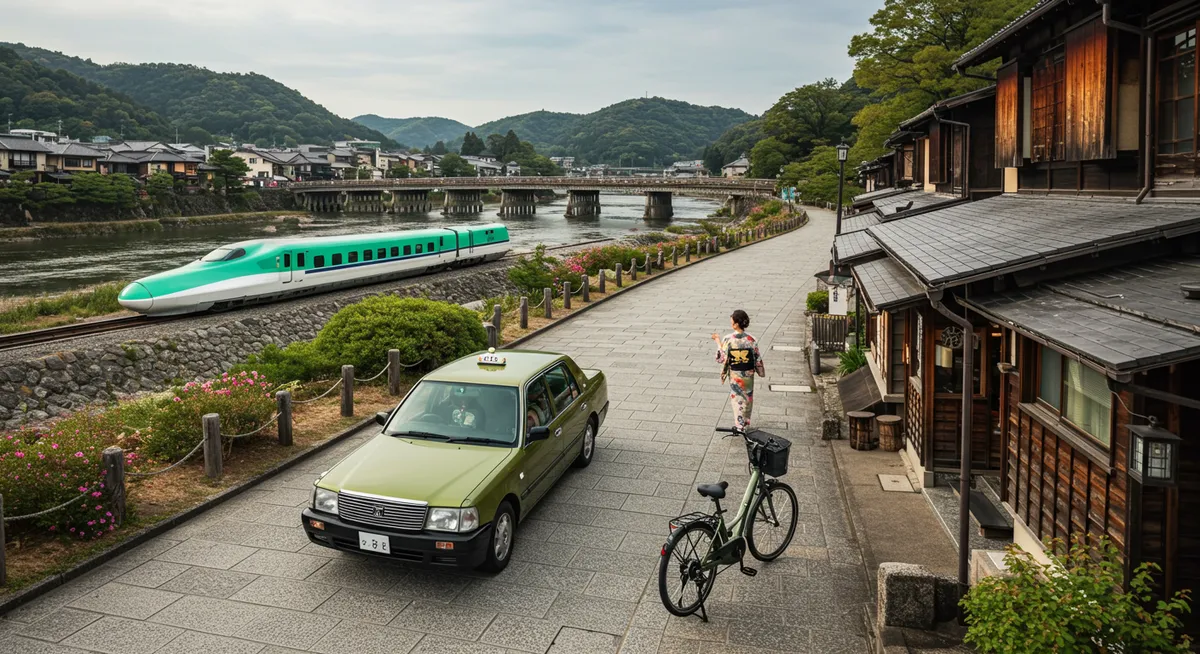Your Ultimate Guide to Navigating Kyoto's Public Transport System
Having explored Kyoto extensively myself, I can confidently say that understanding its public transportation is key to a rewarding visit. This Kyoto transportation guide will demystify the city's network, ensuring you spend less time confused and more time immersed in its breathtaking temples and vibrant districts. From efficient buses to swift subways, getting around Kyoto is surprisingly straightforward once you know the ropes. Find the perfect place to stay with our Kyoto accommodation guide.
Getting Started: The Kyoto City Bus
Plan this trip faster with our free online itinerary maker. Get a personalized day-by-day plan in minutes.
The Kyoto City Bus is truly the backbone of local sightseeing, connecting virtually every major attraction. Mastering the bus system is crucial for any effective Kyoto transportation guide. Most routes operate on a flat fare within the central area, making it easy to hop on and off. You can pay with exact cash, or more conveniently, use an IC card like ICOCA or Pasmo. From my experience, buses can get crowded, especially during peak tourist seasons or rush hour, so allow extra travel time. Remember to enter through the front door and exit from the rear, pressing the fare adjustment button before alighting. Planning your day with a well-structured Kyoto itinerary helps you leverage the bus network efficiently.
Seamless Journeys: Kyoto's Train & Subway Network
For longer distances or to avoid surface traffic, Kyoto's train and subway network offers a swift alternative. The city has two subway lines—Karasuma and Tozai—which are excellent for traversing the downtown area and reaching key districts. Beyond the subway, JR lines connect Kyoto Station to popular spots like Arashiyama, making them indispensable for a comprehensive Kyoto transportation guide. Private railway lines such as Keihan and Hankyu also serve various parts of the city and beyond, offering efficient regional travel. I always recommend familiarizing yourself with the subway map; it saves so much time, especially when planning how many days in Kyoto you'll need to cover all your desired spots efficiently. Travel affordably with our Kyoto budget guide.
Beyond Public Transit: Taxis, Bicycles & Walking
While public transport is superb, other options complement your Kyoto transportation guide. Taxis are ubiquitous and surprisingly affordable, particularly useful for late-night journeys or when carrying heavy luggage. For a more immersive experience, cycling is a fantastic way to explore, with numerous rental shops available. Kyoto's relatively flat terrain makes it ideal for leisurely bike rides, and dedicated bike lanes are becoming more common. However, the true magic of Kyoto often lies in its narrow backstreets and hidden temples, best discovered on foot. Exploring the smaller streets on foot, especially in Gion, reveals hidden gems you'd miss otherwise. Consider the best time to visit Kyoto if you plan extensive walking or cycling, as weather can greatly impact your comfort. Discover the best local cuisine with our Kyoto food guide.
Essential Tips for Efficient Travel in Kyoto
💡 Pro Tip: Book your Kyoto adventures in advance through Viator for the best deals!
To maximize your Kyoto transportation guide experience, consider a daily bus or subway pass if you plan extensive sightseeing. These passes offer unlimited rides and can be purchased at major stations or information centers, often saving money over individual fares. An IC card like ICOCA is incredibly convenient, allowing touch-and-go access on most public transport across Japan. Always use a navigation app like Google Maps; it provides real-time train and bus schedules, making planning much simpler. Purchasing a Kansai Thru Pass or a daily bus pass can offer incredible savings, especially if you plan on visiting many sites. When planning your evenings, remember to check transport times, especially when enjoying things to do in Kyoto at night.
Frequently Asked Questions
What is the most cost-effective way to get around Kyoto?
Are IC cards accepted for all Kyoto transportation?
Is it easy to get around Kyoto without speaking Japanese?
Navigating Kyoto's public transport system is a breeze once you understand its various components. Whether you choose the extensive bus network, the efficient subway and train lines, or opt for the freedom of a bicycle, this Kyoto transportation guide provides the groundwork for a smooth journey. Embrace these options to explore Kyoto's wonders at your own pace. Plan your routes, secure the right passes, and embark on an unforgettable adventure through Japan's ancient capital with confidence and ease.



